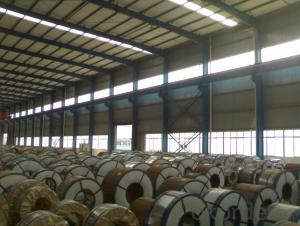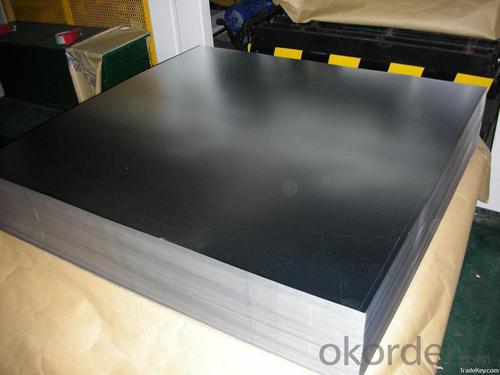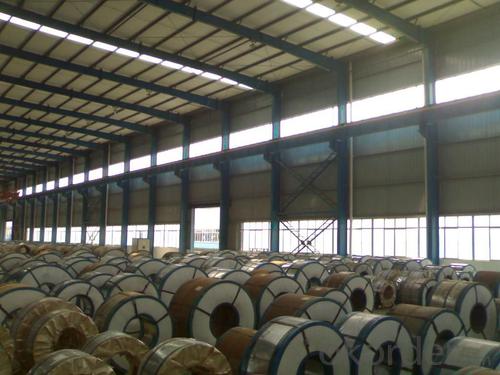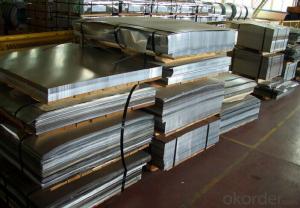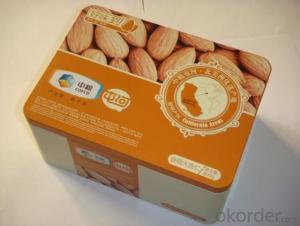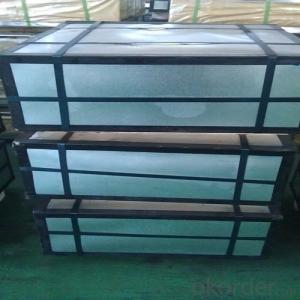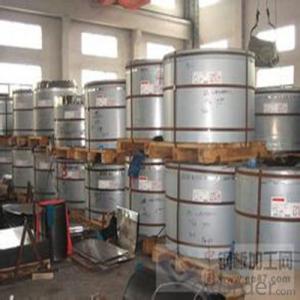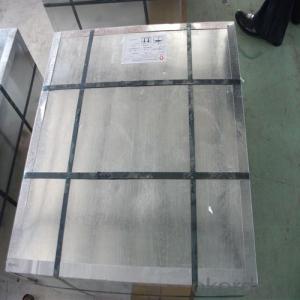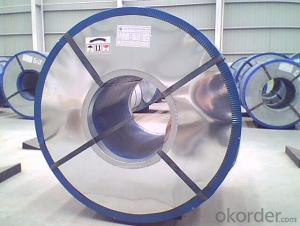Electrolytic Tinplate Coil and Sheets for Tin Cans Making
- Loading Port:
- Tianjin
- Payment Terms:
- TT OR LC
- Min Order Qty:
- 25 m.t
- Supply Capability:
- 7000 m.t/month
OKorder Service Pledge
OKorder Financial Service
You Might Also Like
1.Structure of Electrolytic Tinplate Coil and Sheets for Tin Cans Making Description
Electrolytic Tin Plate Coils and Sheets for Foods Metal Packaging, is one thin steel sheet with a coating of tin applied by electrolytic deposition. Tinplate made by this process is essentially a sandwich in which the central core is strip steel. This core is cleaned in a pickling solution and then fed through tanks containing electrolyte, where tin is deposited on both sides. As the strip passes between high-frequency electric induction coils, it is heated so that the tin coating melts and flows to form a lustrous coat.
2.Main Features of the Electrolytic Tinplate Coil and Sheets for Tin Cans Making
Appearance – Electrolytic Tin Plate is characterized by its beautiful metallic luster. Products with various kinds of surface roughness are produced by selecting the surface finish of the substrate steel sheet.
Paintability and printability – Electrolytic Tin Plates have excellent paintability and printability. Printing is beautifully finished using various lacquers and inks.
Formability and strength – Electrolytic Tin Plates have got very good formability and strength. By selecting a proper temper grade, appropriate formability is obtained for different applications as well as the required strength after forming.
Corrosion resistance – Tinplate has got good corrosion resistance. By selecting a proper coating weight, appropriate corrosion resistance is obtained against container contents. Coated items should meet 24 hour 5 % salt spray requirement.
Solderability and weldability – Electrolytic Tin Plates can be joined both by soldering or welding. These properties of tinplate are used for making various types of cans.
Hygienic – Tin coating provides good and non toxic barrier properties to protect food products from impurities, bacteria, moisture, light and odours.
Safe – Tinplate being low weight and high strength makes food cans easy to ship and transport.
Eco friendly – Tinplate offers 100 % recyclability.
Tin is not good for low temperature applications since it changes structure and loses adhesion when exposed to temperatures below – 40 deg C.
3.Electrolytic Tinplate Coil and Sheets for Tin Cans Making Images

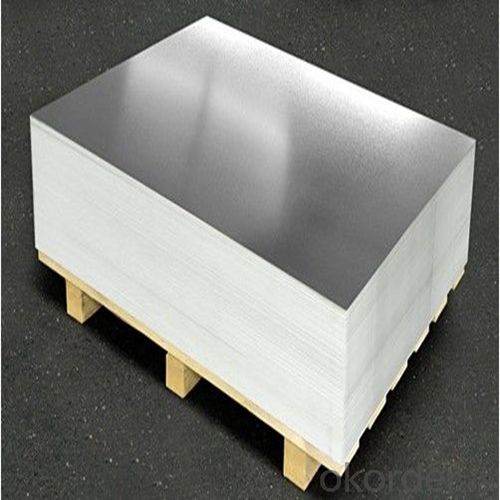
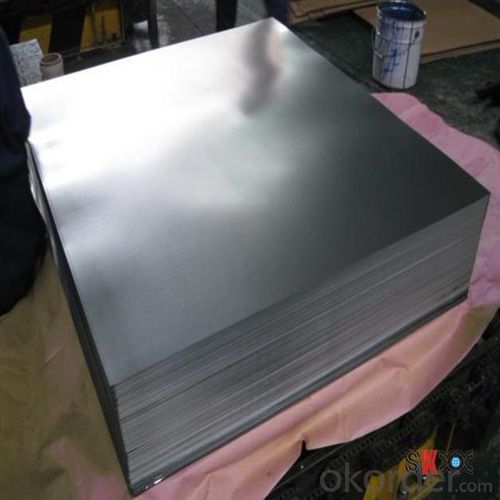
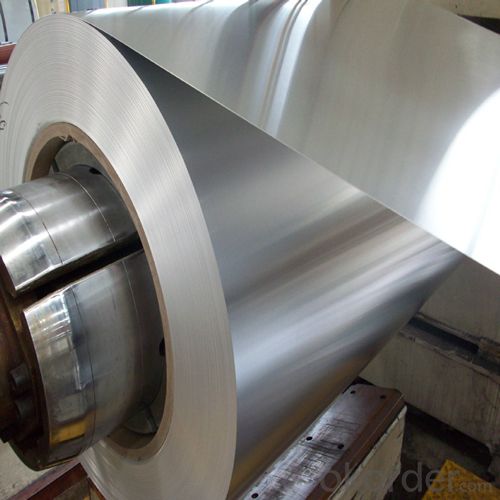
4.Electrolytic Tinplate Coil and Sheets for Tin Cans Making Specification
Standard | ISO 11949 -1995, GB/T2520-2000,JIS G3303,ASTM A623, BS EN 10202
|
Material | MR,SPCC |
Thickness | 0.15mm - 0.50mm |
Width | 600mm -1150mm |
Temper | T1-T5 |
Annealing | BA & CA |
Coil Inner Diameter | 508mm |
Weight | 6-10 tons/coil 1~1.7 tons/sheets bundle |
Passivation | 311 |
Oil | DOS |
Surface | Finish,bright,stone,matte,silver |
5.FAQ of Electrolytic Tinplate Coil and Sheets for Tin Cans Making
-How to place .an order or contact you ?
Please send us Email. we will give you a quick response in seconds .
- How is your quality ?
All our quality is prime even the secondary quality . We have many years experience
In this field with serious quality control standard . Advanced equipment, We welcome your visit to our factory .
- Q: What are the advantages of using tinplate for pharmaceutical packaging?
- There are several advantages of using tinplate for pharmaceutical packaging. Firstly, tinplate is highly resistant to corrosion, ensuring that the integrity of the pharmaceutical product is maintained throughout its shelf life. Secondly, tinplate provides excellent barrier properties against moisture, oxygen, and light, protecting the medication from degradation. Additionally, tinplate is a strong and durable material, providing excellent protection during transportation and handling. Lastly, tinplate is recyclable, making it an environmentally friendly choice for pharmaceutical packaging.
- Q: What are the different ways to store tinplate containers?
- There are several ways to store tinplate containers, depending on the available space and the specific needs of the items being stored. Some common storage methods include stacking the containers on shelves or pallets, placing them in storage bins or crates, hanging them on hooks or racks, or arranging them in storage cabinets or drawers. The chosen method should ensure easy access, proper organization, and minimal risk of damage to the containers.
- Q: What are the considerations for handling and storing tinplate coils?
- There are several important considerations when handling and storing tinplate coils. Firstly, it is crucial to ensure proper handling techniques to avoid any damage or deformation to the coils. This may involve using appropriate lifting equipment and avoiding excessive bending or dropping. Secondly, tinplate coils should be stored in a clean, dry, and well-ventilated area to prevent corrosion. It is also important to protect the coils from direct sunlight and extreme temperatures. Additionally, proper stacking and securing methods should be employed to prevent any accidents or shifting during storage. Regular inspections and maintenance of the storage area and the coils themselves are also essential to ensure their integrity and quality.
- Q: How does tinplate packaging contribute to product protection against moisture?
- Tinplate packaging provides a reliable barrier against moisture due to its inherent properties. The tin coating on the steel substrate prevents direct contact between the product and moisture, acting as a protective layer. This barrier effectively blocks the entry of external moisture, reducing the risk of corrosion, spoilage, or damage to the product. Additionally, tinplate packaging is often hermetically sealed, further enhancing its moisture resistance and preserving the quality and shelf life of the enclosed product.
- Q: What are the typical lead times for tinplate production?
- The typical lead times for tinplate production can vary depending on various factors, such as the complexity of the product, order quantity, and the production capacity of the manufacturer. However, on average, lead times for tinplate production can range from a few weeks to a couple of months. It is recommended to consult with the specific manufacturer for more accurate and up-to-date information regarding lead times.
- Q: What are the limitations of printing on tinplate?
- There are several limitations to printing on tinplate. Firstly, tinplate is not a very smooth surface, which can affect the quality of printed images and text. Additionally, the printing process on tinplate requires specialized inks and equipment, making it more costly and time-consuming compared to printing on other materials. Furthermore, tinplate is prone to scratching and chipping, which can damage the printed design. Lastly, the printing options on tinplate are somewhat limited, as it cannot accommodate intricate or highly detailed designs as well as other printing mediums.
- Q: Can tinplate be used for packaging frozen foods?
- Yes, tinplate can be used for packaging frozen foods. Tinplate is a type of steel coated with a thin layer of tin, which provides protection against corrosion and keeps the food inside safe. It is commonly used in the food industry for various packaging applications, including frozen food containers. Tinplate containers offer good durability, insulation, and can withstand extremely low temperatures, making them suitable for packaging and preserving frozen foods.
- Q: How does tinplate impact the overall product safety?
- Tinplate plays a crucial role in ensuring the overall product safety. Its corrosion-resistant properties provide a protective barrier, preventing contamination and the formation of harmful substances. Tinplate also enhances the product's durability and helps maintain its integrity during transportation and storage. Additionally, tinplate is widely recognized for its food-grade properties, making it a preferred material in packaging food and beverages. Overall, the use of tinplate positively impacts product safety by safeguarding both the contents and consumers from potential risks.
- Q: How does tinplate packaging handle exposure to different chemicals?
- Tinplate packaging is known for its excellent resistance to various chemicals. It can handle exposure to different chemicals without any significant adverse effects, making it a reliable choice for packaging materials.
- Q: What are the main quality standards for tinplate?
- The main quality standards for tinplate include the thickness and uniformity of the tin coating, adhesion strength between the tin and base metal, absence of surface defects such as scratches or dents, and compliance with specific mechanical and chemical properties required for different applications.
Send your message to us
Electrolytic Tinplate Coil and Sheets for Tin Cans Making
- Loading Port:
- Tianjin
- Payment Terms:
- TT OR LC
- Min Order Qty:
- 25 m.t
- Supply Capability:
- 7000 m.t/month
OKorder Service Pledge
OKorder Financial Service
Similar products
Hot products
Hot Searches
Related keywords



